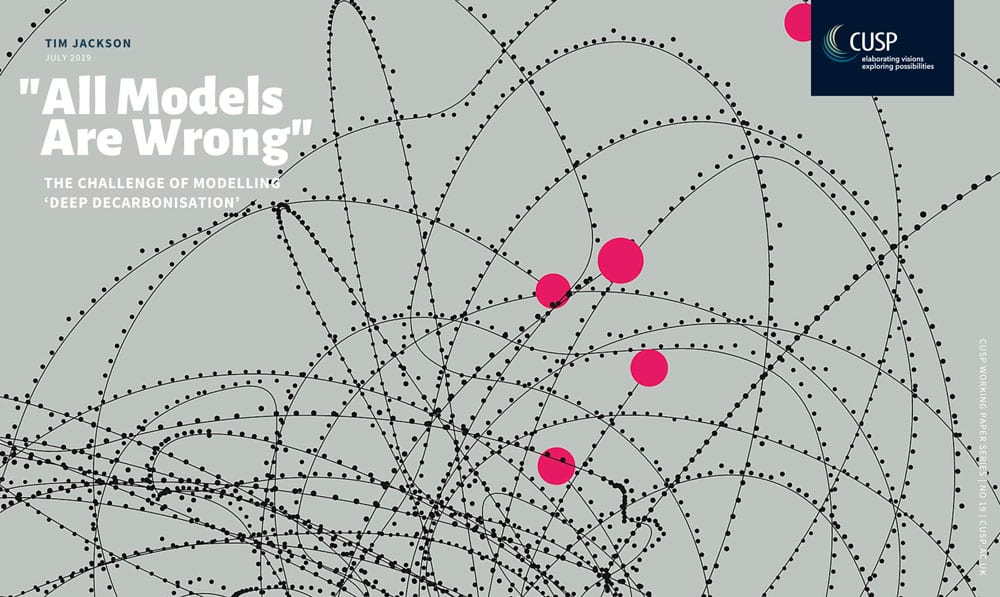“All Models are Wrong”—The challenge of modelling ‘deep decarbonisation’
Tim Jackson
CUSP Working Paper Series | No 19
Summary
This paper summarises the dilemma associated with using mainstream, macroeconomic models to guide disruptive, transformative change such as those that might occur under ‘deep decarbonisation’: a rapid transition to a net-zero carbon economy. On the one hand, some form of macro-economic modelling framework is essential to enable policy-makers to exercise short- and long-term fiscal responsibility. On the other hand, incremental models based on historical behaviour are a poor guide to outcomes under circumstances of disruptive change. The paper briefly reviews the current UK government modelling framework and highlights its relative advantages and shortcomings. It then proposes a pragmatic approach to the challenge based on ‘living with’ the existing framework for now, whilst providing an early signal to establish a ‘new Treasury model’ based on commissioning an immediate in-depth review of the challenge. Such a review could usefully address a range of issues, including: the appropriate remit of a new Treasury model; the institutional architecture of (and responsibilities for) macroeconomic modelling across government; and a set of proposed responses to the challenges associated with modelling disruptive change. Finally, the paper points briefly to a deeper issue on which a transformational economics will depend: the limitations of GDP itself as a measure of economic welfare.
“It is difficult to make predictions, especially about the future.”
Danish proverb [a]
“All models are wrong. But some are useful.”
George Box [b]
Introduction
This paper addresses the macroeconomic modelling challenge posed to the UK government by the need to understand and manage the economy through the transition to net-zero carbon. This challenge is particularly acute for ‘deep decarbonisation’ scenarios such as those associated with the need to remain within a ‘fair carbon budget’. Recent analysis suggests that a fair carbon budget for the UK between now and the end of this century might be as low as 2.5 GtCO2. Scenario analysis indicates that remaining within this budget would require a reduction in the UK’s carbon footprint of around 95% within the space of little more than a decade.[i]
The challenge of decarbonisation is a particular case of a more generic challenge: that of modelling the evolution of the macroeconomy under conditions of disruptive change. The crucial point about this generic challenge is that many economic models ground themselves in and calibrate themselves from historical patterns of behaviour. They also rely rather heavily on assumptions about marginal and incremental changes to equilibrium states. None of these things can be said to apply in the case of fast, deep and potentially disruptive change.
To what extent should criticism of existing models influence a Treasury attempting to deliver a transformational agenda? Are the limitations of these models an inherent impediment to transformational change? Should they be abandoned entirely in favour of a different kind of decision-making process? How exactly should an in-coming government respond to the challenge of understanding the macro-economy, in its first days and weeks in power?
This working paper explores these questions. In the following section, it outlines both the broad critique of conventional models and the reasons for attempting to model the macroeconomy despite this critique. It goes on to explore the existing modelling framework associated with the UK’s ‘Treasury model’, teasing out its salient characteristics and identifying its drawbacks. In the light of this exploration, it suggests a pragmatic approach that might be taken by a government seeking to facilitate transformational change without neglecting fiscal or monetary responsibilities. Finally, it raises the question of the fitness for purpose of the underlying output measure of most macroeconomic models, the Gross Domestic Product (GDP).
Background
The immediate stimulus for this paper came from a working group discussion aimed at developing insights into the transition to a net zero carbon economy. It is now well-rehearsed that there is widespread scepticism about conventional economics—sometimes spilling over into a distrust of the economics profession itself.[ii] What emerged from the workshop was that this distrust poses a serious challenge to any government intent on managing its fiscal responsibilities whilst being equally determined to engage in transformational change.
Critiques of mainstream economics have intensified in recent years for three or four related reasons, primarily of course, the failure of both politicians and economists to predict or prevent the financial crisis in 2008 was attributed in part to failures in the underlying models.[iii] The strongest criticism has been reserved for the prevailing ‘neo-classical’ economic paradigm, which has been accused (amongst other things) of holding unrealistic visions of human behaviour, paying too little attention to dynamic, non-equilibrium processes and protecting the interests of the owners of capital over the rights of labour. A particular failing of conventional approaches is the inability of many aggregated models to incorporate the distributional impact of policy choices or indeed to shed light on the changing nature of income and wealth inequalities. Finally, of course, the nature of the transition to a sustainable economy is inherently difficult to capture in models best suited to predicting incremental change. There are, for example, compelling arguments about the failure of conventional models to capture the transformative impact of new low-carbon technologies.
It is easy enough to sympathise with these critiques, particularly in the context of a desire to make fast and potentially disruptive changes such as those required in the transition to a sustainable economy. At the same time, any government in power assumes certain clear responsibilities. Principal amongst these is the responsibility for short- and long-term fiscal sustainability. The main reason for government to be interested in modelling the macro-economy at all lies in its responsibility for the public finances. This responsibility falls most heavily on Treasury, but it has implications for the architecture of macroeconomic oversight across government, including HM Revenue and Customs, the Office for Budget Responsibility and the Bank of England.
The Treasury Model
Estimates of government spending and receipts over the next period have been published in the ‘Red Book’ since the 19th Century. When Treasury took on the task of providing these estimates from the Cabinet Office in the early 1950s, it began to develop forecasts of the Gross Domestic Product (GDP), world prospects and the balance of trade in a unified framework which became known as the ‘Treasury model’. The first official short-term forecasts were published in the 1968 Red Book, and the requirement on Treasury to produce two short-term forecasts per year was formalised in the 1975 Industry Act. Since that time, the Treasury model has been substantially expanded, with the aim of supporting the government’s fiscal mandate.[iv]
Since June 2010, the Treasury model has been maintained and developed jointly by the Treasury and the Office for Budget Responsibility (OBR). A Memorandum of Understanding sets out the governance arrangements for this joint ownership.[v] Under the provisions of the 2011 Budget Responsibility and National Audit Act, the OBR is now tasked with the production of:
- at least two fiscal and economic forecasts each financial year;
- an assessment of the extent to which the fiscal mandate has been, and is likely to be, achieved;
- an assessment of the accuracy of previous fiscal and economic forecasts; and (at least once in each financial year):
- an analysis of the sustainability of the public finances.
The OBR therefore holds primary responsibility for providing both authoritative forecasts of short-term economic performance and indicative predictions about long term fiscal and financial sustainability. In its 2018 Fiscal Sustainability Report, for instance, the OBR uses the modelling framework to warn of a significant worsening in the UK’s long-term fiscal position. A variety of factors—including demographic change, rising health costs, and the cost servicing the public sector net debt (PSND)—are predicted to lead to a debt-to-GDP ratio of 283% by 2067-8, a fiscal position that is almost certainly unsustainable.[vi]
The Treasury model itself is built around a simplified representation of the National Accounts structure, relating income to spending and saving (or borrowing) across different sectors of the economy. In association with government’s spending plans and a detailed representation of the taxation system, this allows the OBR to forecast the government’s fiscal position in some detail.[vii] The model is constructed using three different kinds of relationships:
- accounting identities
- behaviour (econometric) equations; and
- technical relationships.
Accounting identities impose structural consistency on the model. For instance, the GDP is constructed as a sum of consumer spending, government spending, investment and net exports; and this sum is equal to the sum of incomes (wages, profits and rents) across the economy. Behavioural equations use econometric analysis of historical data to project future dependencies between model variables. For instance, consumer expenditure is estimated in the model on the basis of its relationship to disposable income and household wealth as evidenced by historical statistics. Technical relationships include calibrated relationships based either on economic theory or on broad ‘stylised’ facts—for instance that employee pension contributions represent a constant proportion of wages and salaries.
What is striking about this framework is its preference for policy pragmatism over theoretical ‘rigour’. In the language of models, the Treasury model is a ‘macro-econometric, forecasting model’[viii], whose primary empirical foundation is historical behaviour. Although informed in a broad sense by economic theory, the Treasury model is not predominantly a theoretical model. In representing consumer behaviour, for instance, it prefers statistical evidence of the empirical relationship between income, wealth and spending over the ‘microeconomic foundation’ of the ‘utility maximising consumer’.[ix]
This is in contrast, for example, to HMRC’s computable general equilibrium (CGE) model, designed to compare the impacts of changes in taxation policy against a baseline, or to the Bank of England’s dynamic stochastic general equilibrium (DSGE) model which aims to understand better the dynamics of the business cycle.[x] Both of these latter models are constructed by using micro-economic understandings of ‘rational’ economic behaviour, within a general equilibrium framework.
The Treasury model imposes neither micro-economic foundations nor a general equilibrium framework. As such, some of the criticisms levelled against economics and against economic modelling are inappropriate as criticisms of the Treasury model. In fact, it would be fair to say that macro-economic modelling has improved considerably since the financial crisis—in part due to progressive improvements to the underlying approach led by the OBR and the Bank of England. Nonetheless, it is useful to understand both the advantages and the limitations of the current framework, particularly when it comes to deciding on the appropriate tools with which to understand and manage transformational change.
“All models are wrong…”
The principal advantage of the Treasury model might also be regarded as one of its disadvantages. In preferring historical evidence over economic theory, the model relies heavily on the idea that the past is a reasonable guide to the future. One of the most obvious lessons from the financial crisis is that this is decidedly not the case.
Like many other institutions and a myriad of experts in many different countries, Treasury entirely misread the signs when it came to the events of 2007 and 2008. More accurately, they did not really see the signs, because they were looking in the wrong direction. By focussing primarily on the continuing growth in consumer spending and the GDP, mainstream economists missed entirely the ‘growing fragilities’ that were appearing in the balance sheets of households, businesses and financial institutions.[xi]
It is now broadly recognised that this oversight was critical in the run-up to the financial crisis a decade ago. Those economists who did foresee the crisis mainly came from a perspective where financial flows and balance sheets are integrated into a coherent framework. Notable amongst these was the late Wynne Godley who had himself worked in Treasury during the 1960s and 70s and was closely involved in the early days of the development of economic forecasts.[xii]
Over recent decades, he and his colleagues pioneered an approach to monetary economics known as stock-flow-consistent (SFC) modelling. The model that Godley used to predict not only the timing but the causes of the financial crisis was of this type. Recognising its potential advantages, the Bank of England has recently pioneered an SFC model for the UK economy. As that exercise shows, the challenge of calibrating such a model effectively against historical data is not inconsiderable. But there are clearly some advantages to a more consistent approach to modelling the connection between financial stocks and flows and certainly to paying a careful attention to the financial positions of different sectors of the economy.[xiii]
By contrast, the Treasury approach evolved more conservatively in the decades since Godley worked there. A particular element in the Treasury model lies in ‘anchoring’ the medium-term forecast for the GDP outside the model itself. Broadly speaking, the process of modelling the macro-economy in the Treasury framework consists in forecasting the potential output in the economy outside the main model, and then using the model first to understand how the economy might diverge from this potential output and second to estimate the principal economic ‘aggregates’—such as incomes, consumer spending, investment, and the fiscal balance—in more detail.
This ‘offline’ analysis of potential output relies on two key estimates, one for employment and the other for labour productivity. In its simplest terms the estimated GDP is computed as the product of these two variables. This formulation has the virtue of simplicity and of policy pragmatism. It literally anchors the estimates the model produces to a sense of the historical ‘normal’.
In reality, however, both employment and labour productivity are emergent properties of a complex system. Assuming that the future will look reasonably like the past works well enough so long as things aren’t changing that much. When disruptive or transformational change is involved, this assumption simply does not work at all.
As a particular example of how this can fail, consider how economic growth has tended to fall below forecasts of growth. The reasons for this stem mainly from the reliance of the forecasts on projected labour productivity growth. A typical approach to forecasting labour productivity has been to look at the average productivity growth over preceding years and to use this as the basis for a forecast. A slightly more sophisticated approach is to look at a pre-crisis average and a post-crisis average and to assume that productivity will follow the post-crisis average at first but then return slowly to the pre-crisis average.
But a longer-term analysis reveals that the trend in long-term productivity growth has actually declined more or less consistently over the last fifty years, from a peak of around 4% per annum in the mid 1960s to something around 0.5% in recent years. The causes of this decline are still not understood, much less its trajectory into the future. But an approach which assumes a more or less static (or increasing) trend level of labour productivity growth is likely to be problematic from the outset, anchoring fiscal understanding to a view of the economy which is outmoded at best, and certainly not flexible enough to generate useful insights into transformational change.[xiv]
Several further limitations of the existing framework are worth highlighting. The first relates to the opacity of the model in relation to income inequality. Broadly speaking, the Treasury model—like many policy models—is blind to income and wealth disparities. It therefore misses key social trends, such as the rise in the Gini coefficient that has occurred in the UK since the 1970s or the increasing concentration of wealth in the richest 1% over the last decade. The question of who benefits from economic growth is a critical one. A progressive government intent on transformational change would certainly need a more sophisticated and proactive approach to understanding and addressing this issue, as a recent bill put before the US Senate has also argued.[xv]
Useful tools to explore inequality do exist outside the OBR/Treasury framework. For example, the models developed by the Institute for Fiscal Studies (IFS) have conventionally played a key role in truth-checking the distributional impacts of the Budget.[xvi] But this ‘off-shoring’ of the question of distributional impacts not only downplays the importance of inequality to policy, it also risks missing the dynamic role that distributional inequality can play in the stability of the economy. Some at least of the instability that preceded the crisis arose precisely from these dynamics.[xvii]
Amongst the most obvious limitations of the Treasury model—and of many other macroeconomic modelling frameworks—is the absence of any rigorous account of the environment—in particular, of course, of climate change. Quite often environmental impacts are simply seen as ‘externalities’—lying outside the prevailing economic framework. Occasionally, the economic costs associated with these externalities have been estimated. But long-term external costs are often simply discounted away, using discount rates that may be totally unsuitable to changing economic circumstances.[xviii]
Quite a lot of work has been done, mainly outside Treasury, on the micro-economics of low-carbon alternatives, some at least of which show positive cash-flow advantages over conventional energy technologies that are likely to improve further over time. But the macro-economic implications of the transition to a net-zero carbon economy—such as the ‘stranding’ of existing fossil fuel assets or the financing of low-carbon alternatives—remain underexplored and lie outside Treasury purview almost completely.[xix]
By any account a fast transition to a net zero carbon economy is a formidable challenge. It demands the replacement of entire technologies, supply chains and infrastructures within timescales considerably shorter than the average asset life of the existing investments. Replacement will require directed (or incentivised) investment at a scale usually seen during periods of war or rapid urbanisation, rather than at a scale typical of mature, post-industrial economies. It will also entail widespread changes in the behaviours of households, consumers, producers, investors, shareholders and savers that go well beyond any historically accepted ‘normal’.
These three features of the transition—rapid structural change, massive investment shifts and ‘post-normal’ behaviours pose significant risks to UK fiscal and monetary stability. Indeed, they are emerging as so crucial that the Governor of the Bank of England, Mark Carney, has now committed the Bank to carrying out a robust ‘stress test’ of the resilience of the UK economy against different ‘climate pathways’, to be completed before the end of 2021. It will be ‘the first of its kind to integrate climate scenarios with macroeconomic and financial models’.[xx]
The Treasury model itself lacks the sophistication even to address such questions. Investment is modelled as an aggregate stock-adjustment process, based on expected demand.[xxi] This structure may be fair enough as a replica of historical patterns in a relatively unchanging macroeconomic world. But it fails completely to capture the complexity and inter-sectoral dynamics of a transition from one technological paradigm to another. Neither does the model have a sufficiently granular understanding of the finance sector to address key questions about the financing of the transition.
Taken together, these various limitations represent a formidable set of short-comings. Yet, the challenge with which this note began remains: in the light of these failings, and with clear responsibilities for fiscal and financial stability, how should a government approach the conventional architecture of policy modelling, during its first days and weeks in office?
“Some models are useful”
Perhaps the first and most obvious thing to say is that the dilemma identified briefing paper cannot be resolved simply by rejecting the idea of economic modelling in its entirety. The responsibility of managing fiscal sustainability and financial stability remain. To reject any form of economic model is to inflict a degree of policy blindness in relation to this responsibility that would rightly be considered reckless.
Effectively, this realisation means that any government intent on initiating transformational change would be constrained to ‘live with’ the existing OBR/Treasury framework, at least initially. Depending on the point in the policy cycle at which a significant and potentially disruptive transition is initiated, it may even be necessary to employ the framework almost as is, for example, in order to produce the next half-yearly budget. Nonetheless, an early signal of government’s intention to transform macro-economic policy and the modelling framework would be a highly desirable feature of a policy programme aimed at disruptive change. Arguably, the need to live with the existing architecture (at least initially) makes such a signal even more important, so as to avoid perverse incentives, false impressions and charges of institutional capture.
The most effective and appropriate way to do this would be to commission, at a very early stage, an in-depth review of the macro-economic modelling capability available to government. The terms of reference for such a review would need to be carefully constituted so as not to be seen either to ‘rubber stamp’ the existing architecture or to reject it unnecessarily.[xxii] But carefully constituted, they could provide the groundwork for developing a ‘new Treasury model’ with a remit better suited to today’s wider macroeconomic challenges.
The specific terms of reference for such a review could usefully cover the following key elements:
1 | Appropriate remit
Given the limitations highlighted above it is clear that the existing remit—broadly to provide a forecasting capability for the purpose of meeting short- and long-term fiscal mandates—omits some key areas of concern to a transformational agenda, most notably questions of distributional equity and environmental sustainability. The new mandate should at least relate to these wider concerns and certainly address the critical questions associated with managing transformational change. The review should aim to formulate this new mandate as precisely as possible.
2 | Institutional architecture
The existing modelling architecture is spread across several institutions with various direct and indirect connections to Treasury and to Government. These institutions include the OBR, HMRC, DWP, the Bank of England, as well as a variety of arms-length academic and public sector organisations such as the Institute for Fiscal Studies and the National Institute for Economic and Social Research, all of whom have modelling capabilities which are relevant to the Treasury. This architecture has evolved in a path-dependent way over a period of several decades. It is not necessarily the best architecture for an expanded remit (or indeed for the current remit). The review should suggest ways to bring policy coherence to this architecture.
3 | Modelling challenges
Such a review could also provide a significantly deeper analysis of the various challenges which have been addressed in this short note including:
- inherent trade-offs associated with different modelling approaches;
- the appropriate balance between statistical and conceptual models;
- the data needs associated with an expanded remit;
- the role of financial balances in fiscal and financial stability;
- the generation of a wider range of ‘what-if’ scenarios around key ‘exogenous’ model parameters (such as labour productivity);
- the incorporation of distributional variables into the modelling framework;
- the financial implications of the transition to a zero-carbon society.
With such a review in hand, the next steps would be to address the shortcomings of the existing framework systematically. Not all of these are easy fixes. Some real modelling challenges will inevitably remain, and a degree of realism in relation to the nature of these challenges is vital. Transformational change cannot be calibrated on the basis of past performance. But this reality doesn’t diminish the importance of retaining the capacity to model that change. There are numerous potential responses to the more intractable aspects of this challenge. These include, for example:
- allowing for a wider set of parameter variations in model forecasts and simulations;
- creating a wider range of ‘what if’ scenarios;
- increasing the pluralism of the modelling framework itself;
- revisiting the off-model structure of key forecasts; and
- enhancing the transparency and pluralism of the process of judgement involved in using the model.
The last of these factors is of particular importance in the context of the disruptive changes that might be precipitated by deep decarbonisation. Tightly-formulated and relatively technocratic review processes are efficient in the context of incremental change, but detrimental as soon as historical calibrations become untrustworthy. In this case, effective governance will require a wider and more flexible representation within the process of judgement and oversight.
Concluding remarks
Faced with the challenge of managing disruptive change in the transition to a net zero carbon economy, there is an urgent need to review the adequacy and fitness for purpose of the macroeconomic modelling frameworks available to government. The broad focus of the dominant framework is the so-called ‘Treasury model’. The evolution of this framework is path-dependent with roots that stretch back to the 19th Century. The most recent extensive changes were those introduced in 2010, shortly after and in response to the financial crisis. As these changes demonstrate, the remit and governance of macroeconomic oversight is inevitably a contingent process which must remain reactive to the circumstances and demands of the day. There is an urgent need to review the broad framework at this critical point in time and to suggest changes to allow for a more flexible and pro-active understanding of the demands associated with deep decarbonisation.
One final concern relevant to the overall challenge is worth commenting on briefly. It relates to the central focus of the Treasury framework—namely the GDP itself. The limitations of a focus on the GDP in terms of understanding macro-economic stability have already been remarked on. But critiques of the GDP go much deeper than this, covering both technical and philosophical limitations of this key policy indicator.[xxiii] As Senator Robert Kennedy once remarked, the GDP measures ‘neither our wit, nor our courage; neither our wisdom nor our learning, neither our compassion, nor our devotion to our country. It measures everything in short except that which makes life worthwhile.’[xxiv]
Since that time, critiques of the GDP, hailing from some surprisingly mainstream sources, have built an extensive repertoire of the failings of the single most prominent policy measure around which the Treasury model is constructed. In a separate CUSP Working Paper we have explored the potential options for broader and more appropriate measures of prosperity.[xxv] It would be timely to revisit this challenge—as a key element within the review and subsequent development of a ‘new Treasury model’.
Notes
[a] This saying is often attributed to the Danish physicist Niels Bohr (see Ulam, S 1976. Adventures of a Mathematician, p286), but almost certainly predates this.
[b] Box, G 1976. Science and Statistics. J Am Stat Ass 71(356). Online at: https://www.jstor.org/stable/2286841?seq=1#page_scan_tab_contents.
[i] Jackson, T 2019. Zero Carbon Sooner—the case for an early zero carbon target for the UK. CUSP Working Paper number 18. Online at: www.cusp.ac.uk/zero-carbon-sooner.
[ii] Rethinking Economics 2017. 33 Theses for Economic Reformation. London: Rethinking Economics & The New Weather Institute. Online at: http://www.rethinkeconomics.org/projects/reformation/.
[iii] See for example: Zhengelis, D 2017. The Role of Modeling and Scenario Development in Long-Term Strategies. Online at:
http://www.wri.org/climate/expert-perspective/role-modelling-and-scenario-development-long-term-strategies. For a broader critique see for example: Reed, H 2018. ‘Rip it up and start again, the case for a new economics’. Online at:
https://www.prospectmagazine.co.uk/magazine/the-case-for-a-new-economics. For a robust response to this kind of critique see Coyle, D 2018. ‘In defence of the economists’. Online at: https://www.prospectmagazine.co.uk/economics-and-finance/dianecoyle.
[iv] For an overview of the early history of UK Treasury economic forecasting see: Pike T and D Savage 1998. Forecasting the public finances in treasury. Fiscal Studies 19(1): 49–62. Online at:
https://www.ifs.org.uk/fs/articles/fspisav.pdf. For more recent history see, for instance: http://obr.uk/topics/obr-macroeconomic-model/ and references therein.
[v] http://obr.uk/docs/dlm_uploads/obr_memorandum040411.pdf
[vi] http://cdn.obr.uk/FSR-July-2018.pdf
[vii] For detail of the current version of the model see: http://obr.uk/docs/dlm_uploads/Final_Model_Documentation.pdf. For more detail on the forecasting approach itself see: http://obr.uk/docs/dlm_uploads/Forecasting-the-economy.pdf.
[viii] Such models are sometimes referred to as ‘new Keynesian’ models, owing to their primary focus on the disaggregation of the demand side of the economy.
[ix] The term ‘micro-economic foundations’ is used to refer to an underlying conceptual model of the behaviour of economic agents. For example, the model of utility maximisation proposes that consumers (households) always act in such a way as to maximise their own utility over the long run.
[x] See HMRC 2013. HMRC’s CGE Model Documentation. Online at:
https://assets.publishing.service.gov.uk/government/uploads/system/uploads/attachment_data/file/263652/CGE_model_doc_131204_new.pdf. For the Bank of England modelling framework see: Bank of England 2013. The Bank of England’s Forecasting Platform. Working Paper 471. Online at:
[xi] Barwell, R and O Burrows. 2011. Growing Fragilities? Balance Sheets in the Great Moderation. Bank of England. Online at: https://www.bankofengland.co.uk/-/media/boe/files/financial-stability-paper/2011/growing-fragilities-balance-sheets-in-the-great-moderation.
[xii] For a useful overview of successes and failures in foreseeing the crisis see: Bezemer, D 2009. No-one saw this coming—understanding the financial crisis through accounting models. Online at: https://www.rug.nl/research/portal/files/2646456/09002_Bezemer.pdf.
[xiii] Godley, W et al 2007. Is There a Way Out of the Woods? Online at: http://www.levy.org/. See also: Burgess S et al 2016. A dynamic model of financial balances for the UK. Bank of England. Online at:
[xiv] See Jackson, T 2018. Understanding the new normal—the challenge of secular stagnation. Briefing paper for the APPG on Limits to Growth. Online at: http://limits2growth.org.uk/publication/aetw_no1/.
[xv] See the ‘Measuring Real Income Growth Act of 2018’, introduced by Democratic Senators Chuck Schumer and Martin Heinrich. Online at: https://www.democrats.senate.gov/imo/media/doc/Distributional%20GDP%20legislation_one%20pager_8.28.18.pdf.
[xvi] See: https://www.ifs.org.uk/publications/12858.
[xvii] See for example: Oxfam 2017. Financing inequality. A report to the Financial Conduct Authority. Online at:
https://fca.org.uk/publication/research/financing-inequality.pdf. See also Credit Suisse 2014.
[xviii] See for example: http://www.lse.ac.uk/GranthamInstitute/publication/the-economics-of-climate-change-the-stern-review/.
[xix] See for example on low carbon technologies: https://newclimateeconomy.net/publications; on stranded assets: https://www.carbontracker.org/reports/unburnable-carbon-wasted-capital-and-stranded-assets/; and on financing low carbon technologies: https://cusp.ac.uk/themes/aetw/ag_green-infrastruture/.
[xx] https://www.bankofengland.co.uk/-/media/boe/files/speech/2019/enable-empower-ensure-a-new-finance-for-the-new-economy-speech-by-mark-carney.pdf
[xxi] See OBR 2011, op cit.
[xxii] A useful example of such a review is the one recently commissioned for the Australian government: Murphy, C 2017. Review of Economic Modelling at the [Australian] Treasury. Independent Economics. Online at: https://cdn.tspace.gov.au/uploads/sites/99/2017/05/Review-of-Economic-Modelling-at-Treasury.pdf.
[xxiii] See for example: Credit Suisse 2018. The Future of GDP. Online at: https://www.credit-suisse.com/media/assets/private-banking/docs/uk/the-future-of-gdp-en.pdf. See also: Coyle, D 2016. Economics: GDP in the Dock. Nature 534: 472-4. Online at: https://www.nature.com/articles/534472a?WT.mc_id=TWT_NatureNews.
[xxiv] Jackson, T 2018. ‘Everything except that which makes life worthwhile’. Blog online at: https://cusp.ac.uk/themes/aetw/rfk-gdp50/.
[xxv] Corlet-Walker, C and T Jackson 2019. Measuring Prosperity—Navigating the options. CUSP Working Paper No 20 (forthcoming).
Download full paper (pdf, 2MB) | Jackson T 2019: “All Models Are Wrong”—The challenge of modelling ‘deep decarbonisation’. CUSP Working Paper No 19. Guildford: University of Surrey.





